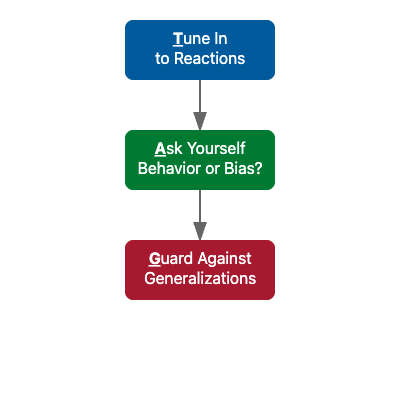Bias can sneak into interviews and debriefs, even when you’re trying to be fair. The way you handle these moments sets the tone for your whole hiring process. Spotting and addressing bias as it happens helps your team make smarter, more equitable decisions and creates a better experience for every candidate.
In this lesson, you’ll learn how to:
- Notice bias in yourself and others, right when it shows up
- Gently steer conversations back to fairness and evidence
- Set a positive example for inclusive, objective interviewing
Bias often shows up as snap judgments or vague feelings — like, “They seemed nervous, so I doubt they can handle pressure,” or “I just have a good feeling about this candidate.” These are signs that first impression bias, halo effect, or affinity bias might be at play.
To catch bias in real time, use the TAG method:

- Tune in to your gut reactions and the words people use.
- Ask yourself: “Am I basing this on specific, job-relevant behaviors, or just a feeling?”
- Guard against generalizations—notice when the conversation drifts to vague comments or personality traits, and pause to refocus on what you actually observed.
The TAG method helps you quickly spot and interrupt bias before it shapes your decisions.
When bias pops up, the goal isn’t to call someone out — it’s to keep things fair and focused. Instead of confronting or criticizing, aim to create a supportive environment where everyone feels comfortable reflecting on their own thinking. You can do this by gently steering the conversation back to evidence and agreed-upon criteria. This approach encourages open dialogue, reduces defensiveness, and helps the team stay aligned on making objective, equitable decisions. By focusing on observable behaviors and job-related examples, you reinforce a culture where fairness and consistency are the priority.
Here’s how this might sound in a real debrief:
- Ryan: I’m not sure about this candidate. They seemed really nervous, and I just don’t think they’d handle pressure well on our team.
- Natalie: I noticed the nerves too, but I want to make sure we’re focusing on what they actually did. For example, during the technical challenge, they asked clarifying questions and explained their thought process clearly. That shows good communication under stress.
- Ryan: That’s true, I did see them clarify requirements before starting. Maybe I was letting my first impression get in the way.
- Natalie: It’s easy to do. Let’s stick to the evidence from their responses so we’re fair to everyone.
Notice how Natalie uses specific examples to ground the conversation in facts, not feelings. She models fairness and helps Ryan see where bias might be creeping in.
If you find yourself in a similar situation and someone asks why you’re so focused on evidence, you can explain:
“Focusing on evidence and our agreed criteria helps us make fairer decisions and keeps us consistent across candidates.”
By consistently redirecting to observable actions and structured questions, you set a standard for your team. This approach not only reduces bias in the moment, but also encourages a culture of accountability and fairness throughout your hiring process. You’ll get to try these skills in real-world scenarios next. This is your chance to build confidence in recognizing and addressing bias in real time, so your interviews stay fair, inclusive, and focused on what really matters.
